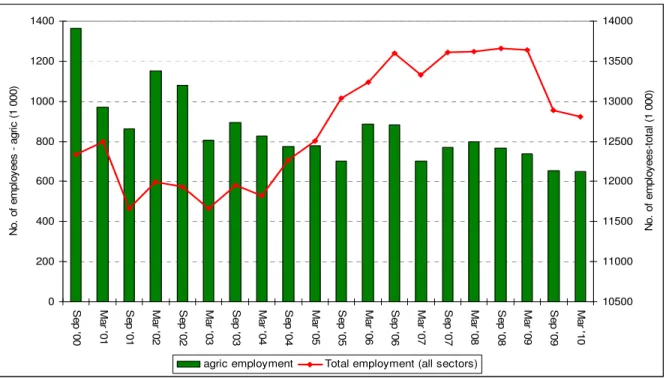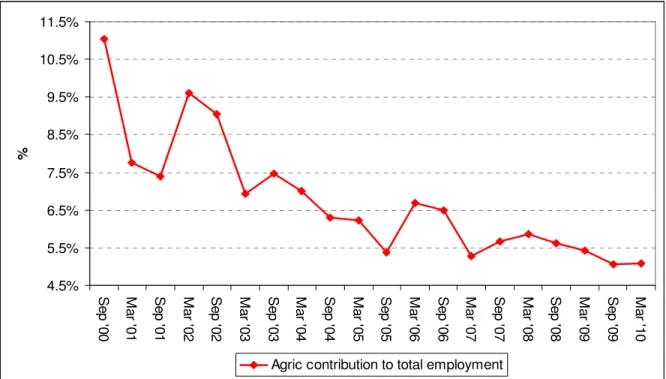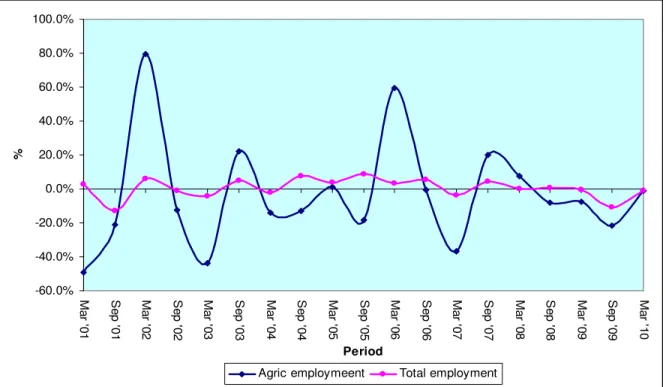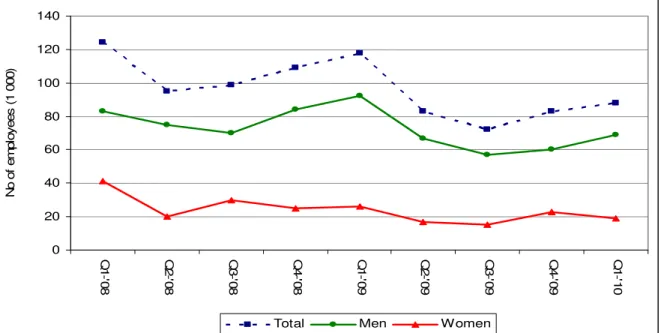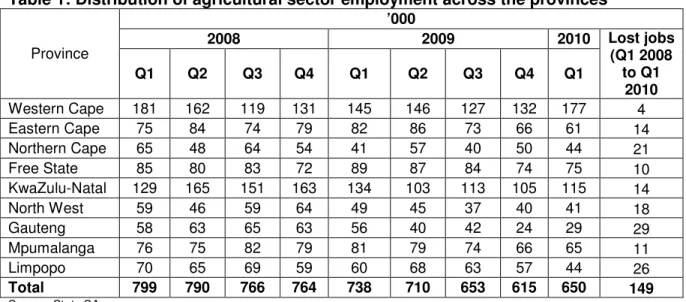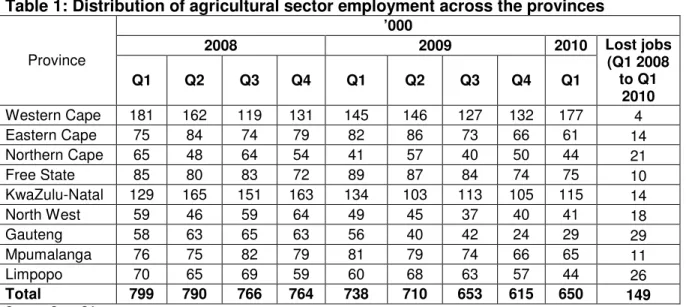This study analyzes the contribution of agriculture, forestry, fishing and hunting to decent employment in the South African economy. The descriptive analysis, using Stats SA data, shows that employment in the sector is declining to a large extent and that its relative contribution to total employment is declining.
Introduction
According to the Department of Labor (2001) and Pekeur (2010), agricultural workers earn the lowest wages among those formally employed in the country. It also provides some information on working conditions for employees in the agricultural sector.
Objectives
This issue of decent employment is not only important to South Africa, but is also one of the main goals of the International Labor Organization (ILO). Empirical studies on employment in agriculture” (section 6) discusses the findings of other authors regarding the drivers of employment in the agricultural sector.
Definitions
Definition of unemployment and decent employment
Although the idea of unemployment as defined above is quite clear, the concept of decent work is less so especially in the agricultural sector in South Africa. Draham (2003) defines the concept of decent work as referring not only to workers in the formal economy, but also to unregulated wage workers, the self-employed and home workers, and most importantly that it embraces safety at work and healthy working conditions.
Types of unemployment
The authors point out that complications in the application of these definitions also arise from the fact that other countries (for example, the United States of America) additionally differentiate the ways of looking for a job. Seasonal unemployment: “It occurs as a result of normal and expected changes in economic activities during a year.
Historical background of the agricultural sector employment in South Africa
In 1996, casual worker compensation in the commercial agricultural sector was only about a quarter (26%) of permanent worker compensation (up from 19% in 1990). The BCAA provides for minimum conditions regarding working hours, leave, overtime, etc., the UIA provides for contributions to the Unemployment Fund and the ALA provides for the application of the Labor Relations Act (1956) and the further application of the Basic Law. Employment Conditions Act (1983) on agricultural activities and employers and employees involved.
Study approach
In this study, a descriptive analysis was used to determine the contribution of the agricultural sector to total employment within the economy of South Africa. Second, agricultural employment was calculated as a percentage of the country's total employment, and the share of agriculture in total employment was also graphed to show the trend between 2000 and 2010. The trend in agricultural employment was compared graphically with employment trends in other economic sectors.
The semester-to-semester percentage changes in total employment and the sector employment were calculated and annualized and the trends in the annualized percentage changes were also graphically depicted. The provincial sector employment distribution is tabulated and the employment distribution in relation to gender is graphed. The data on the minimum wage and the average earnings of the people working in the agricultural sector were used to determine the deviation of the compensation of people working in the sector from the minimum wage established by the state.
The literature review was also used to identify the drivers of employment in the agricultural sector.
Empirical studies on unemployment
Drivers of employment in the agricultural sector
- Regulatory environment
- Adoption of new production methods/technology
- Promoting innovation and entrepreneurship (new business formation)
The debate on employment and employment statistics has focused mainly on the adoption of a narrow definition of the term by the South African government in the late 1990s (Kingdon and Knight, 2000). It is also clear from the long-term trends identified in Kirsten and Vink (2001), Aliber et al. 2007) and Aliber and Simbi (2000) that there was an absolute decline in employment in the agricultural sector. This section explores the drivers of employment in the agricultural sector and the findings will be used to formulate future recommendations on job creation in the sector.
A non-exhaustive list of drivers of employment in the agricultural sector is discussed below, and it will be followed by an assessment of the decency of agricultural work. A study by Aliber et al. 2007) predicts that the adoption of labour-intensive technologies such as animal traction rather than mechanical traction could result in a 30%. increase in employment in the formal agricultural sector in 20206. According to Simbi and Aliber (2000), mechanization and modernization in the agricultural sector has a major impact on employment in the sector.
The listing of the type of start-ups in the agricultural sector is of particular importance as it can also determine the long-term economic viability and sustainability of agricultural projects.
Assessment of decency of farm work
Between March 2010 and July 2010, the Ministry of Agriculture, Forestry and Fisheries coordinated provincial summits and a national summit with the aim of providing a platform for stakeholder engagement and dialogue on issues primarily affecting farm workers, landowners and farmers to develop a common program with clear goals, give a voice to farm workers and address the challenges they face every day. During the national summit, a long list of challenges, together with resolutions, was drawn up regarding working conditions, social determinants of health, job security, empowerment and training. Some examples of challenges faced by farm workers as noted at the summit include the persistence of child labor and unfair labor practices, abuse of vulnerable farm workers by labor brokers, farm workers not being informed of their rights in terms of labor - and laws on basic conditions, lack of access to socio-economic rights, human rights violations of vulnerable workers in the sectors (including physical, mental, emotional and economic abuse, as well as gender discrimination), workers in the agricultural sector who do not have access to basic services (water , electricity, housing, sanitation and healthcare), etc.
Trends in employment and wages in the agricultural sector
Employment trends in the agricultural sector and total employment
Looking at the increase in total employment from September 2000 to March 2009 (the period before including the effect of the economic recession on employment), total employment increased by 1.3 million, i.e. although total employment in the period under Well, employment in the agricultural sector has decreased by more than half, i.e. the share of the agricultural sector in total employment has fallen by more than half in about 10 years.
It is clear that the percentage change in total employment is more stable than in the agricultural sector employment. In most cases, total employment registers a positive annualized semester-to-semester growth, while the opposite is true for employment in the agricultural sector. From September 2000 to March 2010, annualized semester-to-semester growth in total employment averaged 0.6%.
From September 2000 to March 2010, annual semester-on-semester growth in employment in the agricultural sector averaged 3.0%.
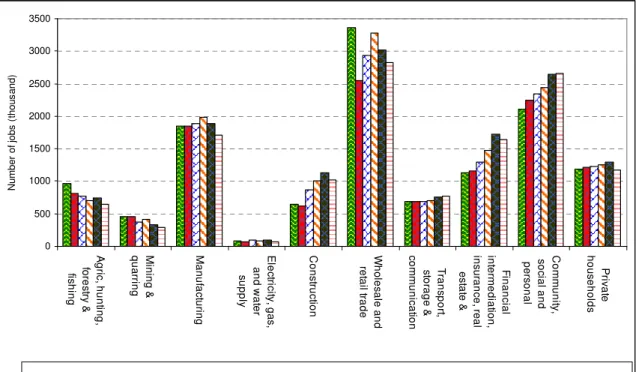
Trends of employees in the sector by gender
Although employment in the agricultural sector is reported in the thousands, it is a worrying factor that less than 20% of the employees in the sector are skilled workers. In the first quarter of 2008, the Western Cape and KwaZulu-Natal employed the largest number of workers in the agricultural sector, i.e. the two provinces were followed by the Free State, which employed 85,000 people (11%) in the sector had.
Higher agricultural investment seen in these three provinces may be one of the reasons why they offer the highest number of jobs. According to Stats SA (2007c), the market value of agricultural assets, agricultural debt, total agricultural expenditure and agricultural gross income are higher in these provinces than in other provinces. The provinces that employ the lowest number of workers in the sector are the North West and Gauteng provinces with respectively
The provinces that lost the highest number of jobs between the first quarter of 2008 and the first quarter of 2010 are Gauteng and Limpopo, which lost 29,000 and 26,000 jobs respectively.
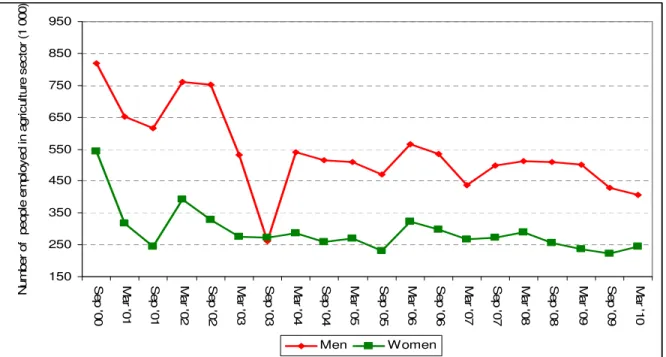
Average farm worker’s earnings versus minimum wage
Even though Figure 7 shows that farm workers are paid above the minimum wage, African farm workers who made up 79.6% in 2001 earned less than white farm workers. For example, in 1996 the level of compensation received by Africans was barely 12% of that received by whites (Statistics South Africa and national Department of Agriculture, 2000). Above and beyond the average earnings in the agricultural sector, it is important to consider how earnings are distributed among racial groups.
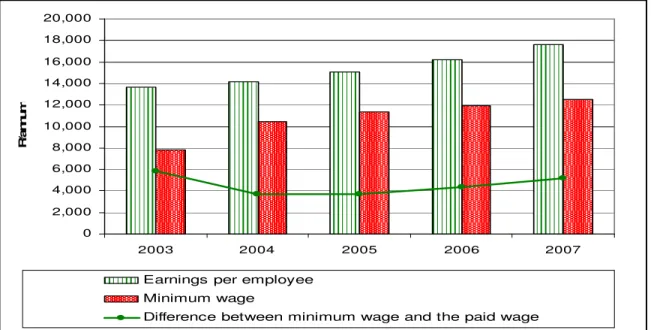
Summary of the findings
The literature identifies two additional drivers of employment in the agricultural sector, namely (i) the introduction of new production technology, which various authors believe lowers the demand for agricultural labor (e.g. the use of chemicals such as herbicides and efficient harvesters). ), (ii) promotion of innovation and entrepreneurship, which will result in the formation of new agricultural enterprises and thus create employment opportunities depending on the type and intensity of work. The literature shows that the wages received by agricultural workers are lower than the wages received by workers in all the other sectors. On average, farm workers are paid above the minimum wage, even though African farm workers earn less than white farm workers.
Conclusion
Farm workers are paid above the minimum wage on average even though they work under questionable conditions.
Scope for further research
Unemployment in South Africa: Descriptors and Determinants, accessed from http://www.commerce.uct.ac.za on 14 May 2010. Rotten Fruits 2: South African Farm Workers Pay a High Price for Profits, Women on Farms Project ( WFP) ), Stellenbosch. Ministry of Economic Development, Ministry of Environmental Affairs, Ministry of Science and Technology and Ministry of Trade and Industry (2010): Green Economy Summit Discussion Paper.
Agricultural Market Reforms and the Rural Poor in South Africa: A Research Paper, PLAAS Poverty Workshop 2009. Unpublished report submitted to the National Ministry of Agriculture by the University of Pretoria in collaboration with A.T. Fischer and information decision systems. 2010), Agricultural workers in South Africa today are heavily exploited: Sikhula Sonke, available from http://www.ssonke.org.za/. 2010), Farmworkers Today: The Legacy of Slavery Continues.
A cost function approach. 1995), Testing the induced innovation hypothesis in South African agriculture (an error correction approach).
